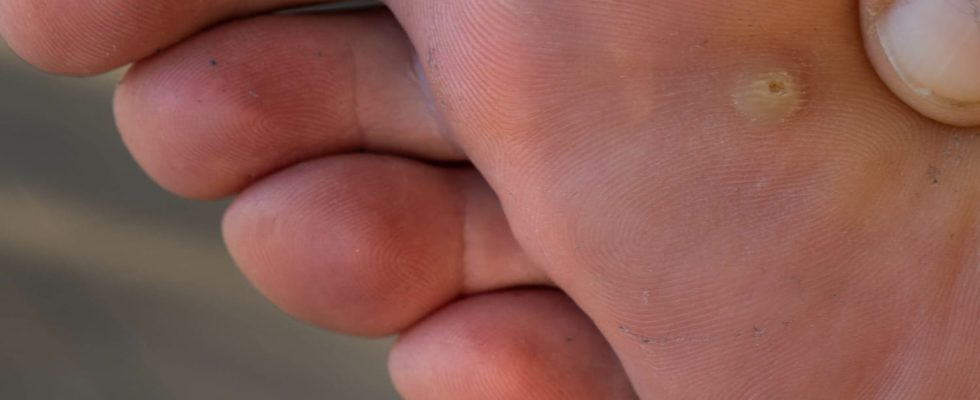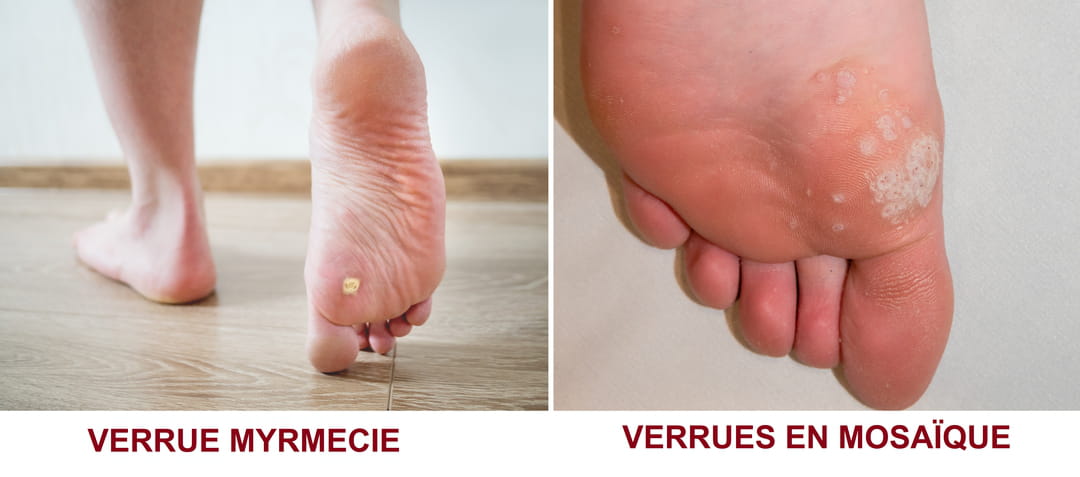With its black dots in its center, the plantar wart (foot wart) is common, benign but also unsightly. Pig ointment, cryotherapy, natural remedies… There are several treatments to get rid of it.
The plantar wart is a skin lesion on the foot caused by a viral infection (HPV virus). Plantar warts affect 7 to 10% of the population general and affect more especially children and adolescents, with a peak frequency between 10 and 14 years. Why do we get plantar warts? What are the places at risk ? The swimming pools? How to get rid of ? Yourself at home? Naturally? With pharmacy treatment? Of pig ointment ? Essential oils? Nitrogen?
What is a plantar wart?
Warts are benign lesions of the epidermis, which appear in the form of rough growths, located on different parts of the body. “Plantar warts are usually located on the horn and toesmore rarely on the thinner skin of the arch of the foot. informs Dr Dominique Penso-Assathiany, dermatologist, member of the French Society of Dermatology. It exists two types of plantar warts:
- Myrmecia: it is characterized by the presence of a so-called “keratotic” ring (delimited thickening of the epidermis), the center of which is dotted with black dots. Myrmecia is usually single or includes only a few units (less than 4).
- Mosaic warts: they form a set of more superficial warts.
Photos of a plantar wart
The plantar wart is characterized by a rough surface with excess thick skin and small black dots in the center (see photo below), which correspond to small blood vessels that have burst.
When the plantar wart dies, it leaves room to a layer of dead skin (white layer) which will fall naturally. The healing will reabsorb the hole.
If it’s itchy, it should go away soon.
What are the symptoms of a plantar wart?
Most often, plantar warts appear in the form of small growths of skin that are rough to the touch. Symptoms of plantar warts depend on the type of wart. “Myrmecia is a circle of skin with blackheads in it. It’s a deep and often painful wart when supporting the foot, informs the dermatologist. Mosaic warts are smaller warts, grouped in patches, superficial and not painful. Warts don’t itch. “If a wart itches, there is inflammation.and it is often the sign that it will soon disappear“.
What is the difference between a wart and a corn on the foot?
Warts can be confused with corns and calluses. “The only way to be sure it’s a wart is to see small black dots and sometimes dermatologists have to scratch to see them.” explains Dr. Penso-Assathiany. “The chemical treatment for calluses and corns and warts is the same so diagnosis is not essential.”
Cause of a plantar wart
Plantar warts, like other warts, are linked to different types of viruses. human papillomavirus virus family (HPV), and are therefore contagious. However, the risk of contagion is low. “There are 120 subtypes of this virus. We carry 5 to 7 subtypes on our skin or mucous membranes. Warts are caused either by one of these viruses or by a virus present in someone else which penetrates our skin via micro-trauma” specifies the specialist. Transmission requires a front door, which is most often a slight skin lesion on the foot (light bulb, outage).
Is plantar wart contagious?
Yes. However, the risk of contagion is low.
“There is no treatment for the virus and the risk of recurrence is significant”
What is the treatment to get rid of a plantar wart?
In the majority of cases, in healthy people, Plantar warts heal spontaneously, within a range of a few months to 2 years. “This is especially the case in adults, a little less in children” specifies Dr Dominique Penso-Assathiany. But their contagiousness (low, remember), and the pain they sometimes cause, can justify appropriate treatment to be able to get rid of them. “There is no treatment for the virus and the risk of recurrence is high.t” however specifies the dermatologist.
Pig ointment and stripping solutions
The first choice treatments for plantar warts are wart removers. based on organic acids (salicylic acidtrichloroacetic acid, formic acid). These preparations exfoliate the wart day after day and locally destroy cells infected with the HPV virus. “To treat warts located on the feet, you must choose solutions with a high dose of salicylic acid, for example MO Cochon® ointment, made from beef tallow with 50% salicylic acid. Be careful, it is very caustic and this requires protecting the surrounding skin. warns Dr Dominique Penso-Assathiany.
Manual : surround the wart with varnish, apply the ointment, cover with a plastic bandage; twice a week, file the surface of the wart with a piece of cardboard file, throw away after use, and apply the keratolytic solution. These stripping treatments are not painful and side effects are rare.
Cryotherapy to destroy the wart in the cold
Another common treatment for plantar warts available in pharmacies is cryotherapy or destruction by cold. There skin surface is frozen from the outside by applying for 20 to 40 seconds a sponge or foam applicator containing a mixture of dimethyl ether and propane which together form a gas reaching a temperature of approximately -50 degrees. Cryotherapy sold in pharmacy rather effective on plantar warts that are not very thick. It is a faster technique – a single application may be enough on small warts – but which has the disadvantage of being painful. She is like this to avoid in children.
Bicarbonate, homeopathy: natural remedies for warts
As for home remedies for warts, such as applying baking sodasnail slime, or even alternative remedies such as homeopathy, “There is no scientific evidence that it can treat warts” informs Dr Dominique Penso-Assathiany.
Scalpel and liquid nitrogen at the dermatologist
If you have a particularly resistant plantar wart, “the dermatologist can cut it out with a scalpel blade to better strip it. It’s painless.”. Local treatments are more effective after this stripping. On the other hand, treatment withliquid nitrogen is not more effective than high-dose keratolytic solutions. “Studies have shown a identical effectiveness between MO Cochon® ointment and liquid nitrogen on the long term” explains the dermatologist.
“The most transmitting place is probably the family bathroom” warns Dr Dominque Penso-Assathiany, And not, as is often said, the swimming pool! To prevent family transmission of warts, it is recommended to:
- Do not exchange towels toilet
- Disinfect the bathtub or shower with a disinfectant product containing bleach.
- Dry your feet well after contact with damp floors in collective areas. Wearing plastic shoes has not been shown to be effective. Generally speaking, the fact of keep your feet clean, dry and well hydrated (by applying moisturizer regularly) prevents warts.
- If you have a foot injury, you can wear a waterproof bandage to prevent possible penetration of the virus.
- When you have a wart, it is recommended that you wash your hands after touching itto avoid the risk of self-transmission.
- During treatment, you can cover your wart with a bandage.
Thanks to Dr Dominique Penso-Assathiany, dermatologist, member of the French Society of Dermatology.

